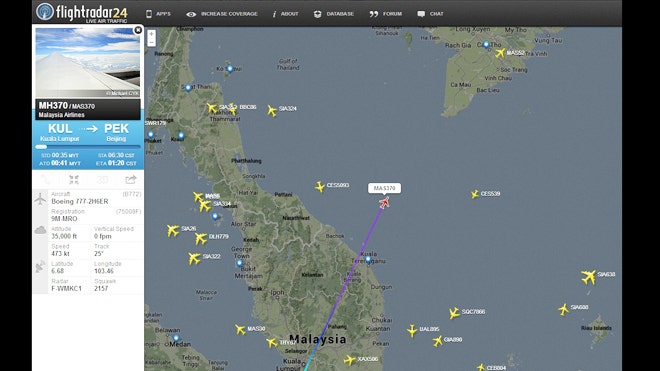Those terrified at the thought of flying may have even more to be worried about with the news of Saturday’s mid-air disappearance of a Malaysia Airlines flight.
After all, the most dangerous parts of a flight are takeoff and landing, with just 9 percent of fatal accidents occurring when a plane is at cruising altitude. And the fact that the Boeing 777 is still missing, with the fate of the 239 people on board still unknown, is even more unsettling.
“The fact that radar contact with the plane was lost, and the plane cannot be found, is difficult for an anxious flier to accept,” says Captain Tom Bunn, a retired pilot and licensed therapist helping people overcome their fear of flying.
“We all have had moments in which we felt disconnected from someone important to us. Disconnection is emotionally difficult for us. So the complete disconnect between us and what happened to this plane and to the people on the plane is hard to take.”
As the search continues for the missing plane, many are questioning how it’s possible for a modern aircraft to simply vanish without trace.
The ill-fated flight draws similarities to the doomed 2009 Air France flight 447, whose crash remained a mystery for long time.
The Air France flight, an Airbus A330 flying from Rio de Janeiro to Paris, crashed in the Atlantic midway through the journey, resulting in the death of all 228 people aboard.
Ultimately it was concluded that pilot error led to the crash, but Bunn says speculation at the time led to some misconceptions about what truly happened.
“Speculation led the media to fabricate a story that was completely false – a story fits every fearful fliers worst fears. People still today believe the Air France plane ‘fell out of the sky’ due to turbulence.”
Theories about what happened to the Malaysia Airlines flight — which include everything from a terror attack to a mechanical malfunction –remain speculative, but as of Monday evening none of the clues so far had led searchers to the plane.
Fatal airline accidents like this are rare. So what can you do to control your fears if you’re about to take a trip?
Bunn says stick to the facts. Take heart that the Boeing 777 has been flying for 18 years and had only one crash in which fatalities may have be attributed to the design of the plane.
Also therapy helps, which often includes a series of exercises to lower stress hormones. He says little things like meeting the pilot when boarding lets passengers give up control –an important element to overcoming fear.
His organization, SOAR also has a free Conquers Fear of Flying app that passengers can use to measure turbulence during their flight. Passengers can use it to prove the plane is not in trouble.
“Anxious fliers need to know how safe flying has become. Nothing is perfectly safe, but flying is as close to perfectly safe as we can get,” said Bunn.





Leave a Reply